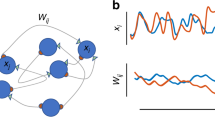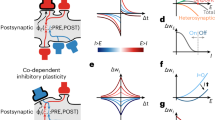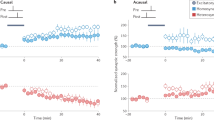Abstract
Cortical networks are thought to be shaped by experience-dependent synaptic plasticity. Theoretical studies have shown that synaptic plasticity allows a network to store a memory of patterns of activity such that they become attractors of the dynamics of the network. Here we study the properties of the excitatory synaptic connectivity in a network that maximizes the number of stored patterns of activity in a robust fashion. We show that the resulting synaptic connectivity matrix has the following properties: it is sparse, with a large fraction of zero synaptic weights ('potential' synapses); bidirectionally coupled pairs of neurons are over-represented in comparison to a random network; and bidirectionally connected pairs have stronger synapses on average than unidirectionally connected pairs. All these features reproduce quantitatively available data on connectivity in cortex. This suggests synaptic connectivity in cortex is optimized to store a large number of attractor states in a robust fashion.
This is a preview of subscription content, access via your institution
Access options
Subscribe to this journal
Receive 12 print issues and online access
$209.00 per year
only $17.42 per issue
Buy this article
- Purchase on Springer Link
- Instant access to full article PDF
Prices may be subject to local taxes which are calculated during checkout







Similar content being viewed by others
References
Braitenberg, V. & Schütz, A. Anatomy of the Cortex (Springer, 1991).
Kalisman, N., Silberberg, G. & Markram, H. The neocortical microcircuit as a tabula rasa. Proc. Natl. Acad. Sci. USA 102, 880–885 (2005).
Trachtenberg, J.T. et al. Long-term in vivo imaging of experience-dependent synaptic plasticity in adult cortex. Nature 420, 788–794 (2002).
Stepanyants, A., Hof, P.R. & Chklovskii, D.B. Geometry and structural plasticity of synaptic connectivity. Neuron 34, 275–288 (2002).
Mason, A., Nicoll, A. & Stratford, K. Synaptic transmission between individual pyramidal neurons of the rat visual cortex in vitro. J. Neurosci. 11, 72–84 (1991).
Markram, H., Lübke, J., Frotscher, M., Roth, A. & Sakmann, B. Physiology and anatomy of synaptic connections between thick tufted pyramidal neurones in the developing rat neocortex. J. Physiol. (Lond.) 500, 409–440 (1997).
Sjöström, P.J., Turrigiano, G.G. & Nelson, S.B. Rate, timing, and cooperativity jointly determine cortical synaptic plasticity. Neuron 32, 1149–1164 (2001).
Holmgren, C., Harkany, T., Svennenfors, B. & Zilberter, Y. Pyramidal cell communication within local networks in layer 2/3 of rat neocortex. J. Physiol. (Lond.) 551, 139–153 (2003).
Thomson, A.M. & Lamy, C. Functional maps of neocortical local circuitry. Front. Neurosci. 1, 19–42 (2007).
Lefort, S., Tomm, C., Floyd Sarria, J.C. & Petersen, C.C. The excitatory neuronal network of the C2 barrel column in mouse primary somatosensory cortex. Neuron 61, 301–316 (2009).
Song, S., Sjöström, P.J., Reigl, M., Nelson, S. & Chklovskii, D.B. Highly nonrandom features of synaptic connectivity in local cortical circuits. PLoS Biol. 3, e68 (2005).
Wang, Y. et al. Heterogeneity in the pyramidal network of the medial prefrontal cortex. Nat. Neurosci. 9, 534–542 (2006).
Perin, R., Berger, T.K. & Markram, H. A synaptic organizing principle for cortical neuronal groups. Proc. Natl. Acad. Sci. USA 108, 5419–5424 (2011).
Ko, H. et al. Functional specificity of local synaptic connections in neocortical networks. Nature 473, 87–91 (2011).
Hopfield, J.J. Neural networks and physical systems with emergent collective computational abilities. Proc. Natl. Acad. Sci. USA 79, 2554–2558 (1982).
Amit, D.J. The Hebbian paradigm reintegrated: local reverberations as internal representations. Behav. Brain Sci. 18, 617 (1995).
Amit, D.J. & Brunel, N. Model of global spontaneous activity and local structured activity during delay periods in the cerebral cortex. Cereb. Cortex 7, 237–252 (1997).
Fuster, J.M. & Alexander, G.E. Neuron activity related to short-term memory. Science 173, 652–654 (1971).
Miyashita, Y. Neuronal correlate of visual associative long-term memory in the primate temporal cortex. Nature 335, 817–820 (1988).
Funahashi, S., Bruce, C.J. & Goldman-Rakic, P.S. Mnemonic coding of visual space in the monkey's dorsolateral prefrontal cortex. J. Neurophysiol. 61, 331–349 (1989).
Romo, R., Brody, C.D., Hernández, A. & Lemus, L. Neuronal correlates of parametric working memory in the prefrontal cortex. Nature 399, 470–473 (1999).
Abeles, M. Corticonics (Cambridge Univ. Press, 1991).
Goldman, M.S. Memory without feedback in a neural network. Neuron 61, 621–634 (2009).
Harvey, C.D., Coen, P. & Tank, D.W. Choice-specific sequences in parietal cortex during a virtual-navigation decision task. Nature 484, 62–68 (2012).
Pfeiffer, B.E. & Foster, D.J. Autoassociative dynamics in the generation of sequences of hippocampal place cells. Science 349, 180–183 (2015).
Gardner, E.J. The phase space of interactions in neural network models. J. Phys. Math. Gen. 21, 257–270 (1988).
Fino, E. & Yuste, R. Dense inhibitory connectivity in neocortex. Neuron 69, 1188–1203 (2011).
Hofer, S.B. et al. Differential connectivity and response dynamics of excitatory and inhibitory neurons in visual cortex. Nat. Neurosci. 14, 1045–1052 (2011).
Mézard, M., Parisi, G. & Virasoro, M.A. Spin Glass Theory and Beyond (World Scientific, Singapore, 1987).
Rosenblatt, F. Principles of Neurodynamics (Spartan, New York, 1962).
Clopath, C., Nadal, J.P. & Brunel, N. Storage of correlated patterns in standard and bistable Purkinje cell models. PLoS Comput. Biol. 8, e1002448 (2012).
Brunel, N., Hakim, V., Isope, P., Nadal, J.P. & Barbour, B. Optimal information storage and the distribution of synaptic weights: perceptron versus Purkinje cell. Neuron 43, 745–757 (2004).
Chapeton, J., Fares, T., LaSota, D. & Stepanyants, A. Efficient associative memory storage in cortical circuits of inhibitory and excitatory neurons. Proc. Natl. Acad. Sci. USA 109, E3614–E3622 (2012).
Markram, H. A network of tufted layer 5 pyramidal neurons. Cereb. Cortex 7, 523–533 (1997).
Gardner, E.J., Gutfreund, H. & Yekutieli, I. The phase space of interactions in neural network models with definite symmetry. J. Phys. Math. Gen. 22, 1995–2008 (1989).
Alemi, A., Baldassi, C., Brunel, N. & Zecchina, R. A three-threshold learning rule approaches the maximal capacity of recurrent neural networks. PLoS Comput. Biol. 11, e1004439 (2015).
Yoshimura, Y., Dantzker, J.L.M. & Callaway, E.M. Excitatory cortical neurons form fine-scale functional networks. Nature 433, 868–873 (2005).
Bathellier, B., Ushakova, L. & Rumpel, S. Discrete neocortical dynamics predict behavioral categorization of sounds. Neuron 76, 435–449 (2012).
Fuster, J.M. & Jervey, J.P. Inferotemporal neurons distinguish and retain behaviorally relevant features of visual stimuli. Science 212, 952–955 (1981).
Nakamura, K. & Kubota, K. Mnemonic firing of neurons in the monkey temporal pole during a visual recognition memory task. J. Neurophysiol. 74, 162–178 (1995).
Yu, Y.C., Bultje, R.S., Wang, X. & Shi, S.H. Specific synapses develop preferentially among sister excitatory neurons in the neocortex. Nature 458, 501–504 (2009).
Clopath, C. & Brunel, N. Optimal properties of analog perceptrons with excitatory weights. PLoS Comput. Biol. 9, e1002919 (2013).
Clopath, C., Büsing, L., Vasilaki, E. & Gerstner, W. Connectivity reflects coding: a model of voltage-based STDP with homeostasis. Nat. Neurosci. 13, 344–352 (2010).
Kasthuri, N. et al. Saturated reconstruction of a volume of neocortex. Cell 162, 648–661 (2015).
Bourgeois, J.P. & Rakic, P. Changes of synaptic density in the primary visual cortex of the macaque monkey from fetal to adult stage. J. Neurosci. 13, 2801–2820 (1993).
Acknowledgements
I warmly thank J. Sjöström for providing his data, and Y. Amit, C. Baldassi, B. Barbour, V. Hakim, D. Marti, G. Mongillo, S. Ostojic, A. Roxin, J. Sjöström and R. Zecchina for discussions and/or comments on previous versions of the manuscript.
Author information
Authors and Affiliations
Corresponding author
Ethics declarations
Competing interests
The author declares no competing financial interests.
Supplementary information
Supplementary Text and Figures
Supplementary Figures 1–3 and Supplementary Note (PDF 654 kb)
Rights and permissions
About this article
Cite this article
Brunel, N. Is cortical connectivity optimized for storing information?. Nat Neurosci 19, 749–755 (2016). https://doi.org/10.1038/nn.4286
Received:
Accepted:
Published:
Issue Date:
DOI: https://doi.org/10.1038/nn.4286
This article is cited by
-
Photonic Stochastic Emergent Storage for deep classification by scattering-intrinsic patterns
Nature Communications (2024)
-
Multimodal Nature of the Single-cell Primate Brain Atlas: Morphology, Transcriptome, Electrophysiology, and Connectivity
Neuroscience Bulletin (2024)
-
Probing the structure–function relationship with neural networks constructed by solving a system of linear equations
Scientific Reports (2021)
-
Recurrence-mediated suprathreshold stochastic resonance
Journal of Computational Neuroscience (2021)
-
Short term memory properties of sensory neural architectures
Journal of Computational Neuroscience (2019)



